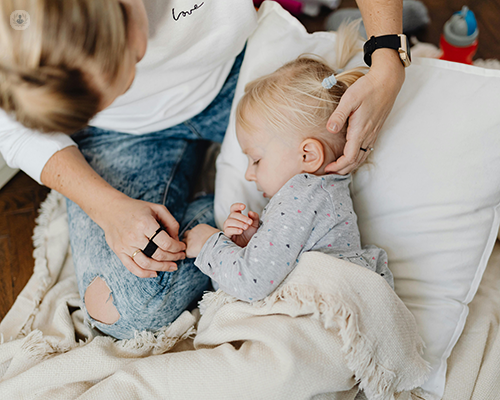What is a paediatric upper and lower GI endoscopy?
Written by:A paediatric upper and lower GI endoscopy is a medical procedure used to visually examine the upper and lower parts of the gastrointestinal tract, helping to evaluate a range of gastrointestinal conditions in children.
Here, Dr Krishna Soondrum, renowned consultant paediatric gastroenterologist, delves into the specifics of the procedure.

Why might my child need an upper and lower GI endoscopy?
A paediatric upper and lower GI endoscopy is recommended to diagnose various gastrointestinal conditions and ailments in children, including:
- Persistent abdominal pain: If your child experiences recurring abdominal discomfort, especially if accompanied by other symptoms such as vomiting or weight loss, an endoscopy might be suggested to investigate the underlying cause.
- Gastrointestinal bleeding: If there are signs of blood in your child's vomit, stool, or both, it is essential to determine the source of the bleeding. An endoscopy can help identify any abnormalities in the upper and lower gastrointestinal tract.
- Inflammatory bowel diseases (IBD): Conditions like Crohn's disease or ulcerative colitis can affect children. Endoscopy plays an important role in diagnosing and monitoring these conditions by examining the lining of the intestines.
- Chronic diarrhoea: Prolonged episodes of diarrhoea in children may indicate various gastrointestinal issues, including infections or malabsorption disorders, which can be evaluated through an endoscopic examination.
What preparation steps are required before an upper and lower GI endoscopy?
Before a paediatric upper and lower GI endoscopy, several preparation steps are necessary to ensure the procedure goes smoothly, including:
- Medical history: You will need to provide detailed information about your child's medical history, including any allergies or previous surgeries, to help the healthcare team plan the procedure accordingly.
- Medication adjustments: You will need to inform your specialist about any medications your child is taking, especially blood thinners or anti-inflammatory drugs, as they may need to be temporarily discontinued or adjusted before the procedure.
- Anaesthesia discussion: Depending on your child's age and the complexity of the procedure, your specialist may discuss the option of sedation or anaesthesia during the endoscopy.
- Fasting: Your child will need to fast for a specified period before the procedure, typically for several hours. This will ensure that the stomach and intestines are empty, allowing for better visualisation during the endoscopy.
How is a paediatric upper and lower GI endoscopy performed?
A paediatric upper and lower GI endoscopy involves the use of an endoscope, which is a flexible, thin tube equipped with a camera and light source at its tip.
During an upper GI endoscopy, the endoscope is passed through the mouth and then advanced through the oesophagus, stomach, and duodenum (the first part of the small intestine). This allows your specialist to inspect the lining of these organs for any abnormalities such as inflammation, ulcers, or bleeding.
During a lower GI endoscopy, the endoscope is inserted through the anus and then guided into the colon (the large intestine). This allows your specialist to examine the colon’s lining for signs of inflammation, polyps, or other abnormalities.
Throughout the procedure, the healthcare team carefully observes the images transmitted by the endoscope on a monitor in real-time, looking for any abnormalities such as inflammation or bleeding. In some cases, biopsies may need to be collected for further analysis.
Are there any potential risks or complications associated with a paediatric upper and lower GI endoscopy?
Although a paediatric upper and lower GI endoscopy is generally considered a safe procedure, there are some potential risks and complications to be aware of, including:
- Anaesthesia risks: If sedation or anaesthesia is used, there is a slight risk of adverse reactions, such as respiratory problems or allergic reactions, although these are rare.
- Bleeding or perforation: In rare cases, the endoscope may cause injury to the gastrointestinal tract, leading to bleeding or perforation. This risk is higher in children with certain medical conditions or anatomical abnormalities.
- Infection: There is always a minimal risk of infection associated with any invasive procedure.
It is important to discuss these risks with your specialist beforehand and address any concerns you may have.
How long does a paediatric upper and lower GI endoscopy take, and when can we expect to receive the results?
The duration can vary depending on factors such as the specific procedure being performed, the child's anatomy, and any findings that may require further investigation. On average, the procedure takes between 30 minutes to an hour.
As for the results, they are often available shortly after the procedure, and the healthcare team can immediately assess and discuss any findings with you. However, if biopsies are taken during the endoscopy, it may take a few days to receive the final pathology results.
What is recovery like after a paediatric upper and lower GI endoscopy?
Recovery after a paediatric upper and lower GI endoscopy is usually quick, and most children can resume their normal activities shortly afterward.
Your child may feel drowsy or tired after the procedure, especially if sedation or anaesthesia was used. Allow them to rest and avoid any strenuous activities for the remainder of the day.
In terms of diet, your specialist may recommend a soft or liquid diet initially, followed by a gradual return to their regular diet as tolerated.
Finally, although rare, it's essential to monitor your child for any signs of complications such as persistent abdominal pain, bleeding, or fever. Contact your specialist immediately if you notice any concerning symptoms.
If you would like to consult an appointment with Dr Krishna Soondrum, head on over to his Top Doctors profile today.


